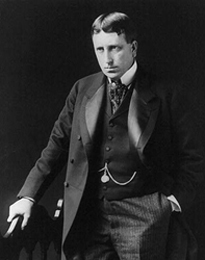The William Randolph Hearst Archive

William Randolph Hearst (1863-1951) Photograph. Library of Congress, Prints and Photographs Division. ca. 1904
In 1972 Long Island University contracted with the Hearst Corporation to house the William Randolph Hearst Archive as part of a plan to develop an art archival division. In 1975, the entire collection consisting of 125 albums that record the sheer monumentality and variety of art items acquired by Hearst, thousands of his art sales catalogues dating as early as 1884, and sundry materials in boxes and file cabinets were transferred from the Hearst estate as a gift to the University with the stipulation that over time they would not be sold.
Four decades have passed since Long Island University accepted the archive as a gift from the Hearst Foundation. Since that time numerous scholars have utilized the meticulous records contained in the albums that recorded the works of art acquired by Hearst during his lifetime and stored in his Bronx New York warehouse. However, a recent reappraisal of the archive discloses much more than the contents of its sales albums. It also contains numerous primary documents that shed light on the opulence of the Gilded Age of which Hearst was a key player, his politics, and most remarkably, his lifelong unique approach to art collecting.
Hearst's vast art collection was valued at least $20 million dollars in 1935 (a quarter of a billion dollars today) yet his method of collecting has never been formally documented. There is no evidence of plans for an art museum. Hearst has been characterized as an accumulator lacking self-discipline and discretion in the acquisition of works of art. Yet extraordinary works of art are now accessible to both researchers and the populace in major museums and private collections worldwide.
New Findings: The contents of an unlabeled cabinet file drawer amid six cabinets of additional unbound sales and shipping records from the Bronx warehouse are equally significant. The drawer with its folders marked A-Z has remained intact and unexplored since its transfer to Long Island University. It contains loose photographs of objects with related correspondence and notations, and detailed drawings, and small paintings of various items. Many of the items were sent by European agents with the intent of further beguiling Hearst's insatiable desire for objects of art. Other striking documents now being explored include blueprints and photographs of important architectural details of Hamilton Palace, Scotland (now lost), as well as drawings of a Gothic oak room from the Manor of Boughton Malherbe, Kent, England.
